Now that some Augmentative and Alternative Communication (AAC) myths have been busted (see the previous blog post), it’s time to introduce, support, and use AAC with your child! Your speech-language pathologist and therapy team can help determine which systems and modalities are most appropriate to trial. Once you have these trial systems in place, here are some considerations, strategies, and tips to think about when supporting your child on his or her AAC journey.
Familiarize yourself with the system
Begin by familiarizing yourself with the AAC system. Borrow it during your child’s nap time, take an approved parent course on the system, observe a therapy session where the system is being used, or train directly with your child’s speech-language pathologist. The more you know, the more comfortable you will be using the system and therefore, the more likely you will be to model on the system!
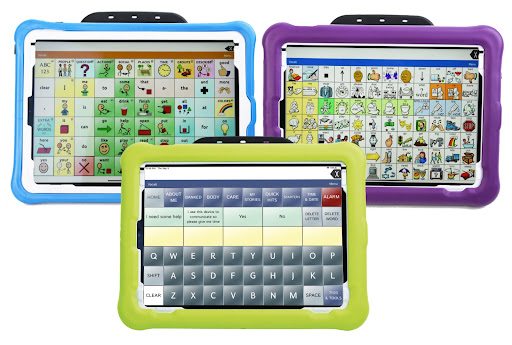
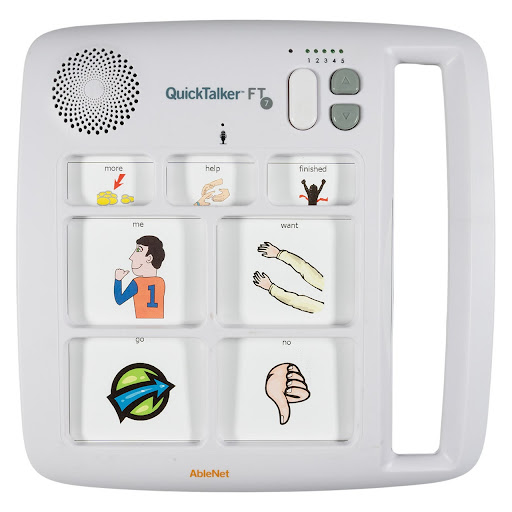
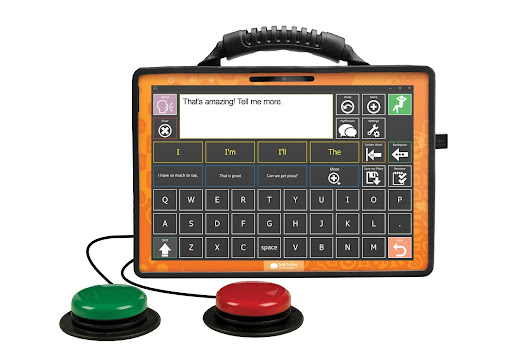
Model, model, model
Children learn through experiences and observation, s
o it’s incredibly important to provide enriching models. We cannot expect a child to know how to use an AAC system without showing them how to use the system first.
Have fun! Then, model some more
When introducing AAC, start by introducing the system during play with motivating games, activities, and toys! Cause-and-effect games and routine based activities are great, as these activities use repetitive language and provide plenty of natural pauses in play where the child can fill-in-the-blank or request.
 For the first few minutes of play, simply demonstrate how to use the system by naturally modeling during play (e.g., selecting “up” on the speech device when placing a car on the top of a race track, pointing to a picture card of an apple when pretending to eat the apple). Then, after the play routine is familiar and the “target” words are established, simply point toward the target word on the AAC system without directly selecting the word. Wait for up to 10 seconds to see if your child will imitate or select the word. After 10 seconds, model it one time then wait again. Do not be discouraged if your child doesn’t imitate right away- it takes time to learn a new system and it takes time to learn language. Keep modeling, keep having fun, and keep positive thoughts!
For the first few minutes of play, simply demonstrate how to use the system by naturally modeling during play (e.g., selecting “up” on the speech device when placing a car on the top of a race track, pointing to a picture card of an apple when pretending to eat the apple). Then, after the play routine is familiar and the “target” words are established, simply point toward the target word on the AAC system without directly selecting the word. Wait for up to 10 seconds to see if your child will imitate or select the word. After 10 seconds, model it one time then wait again. Do not be discouraged if your child doesn’t imitate right away- it takes time to learn a new system and it takes time to learn language. Keep modeling, keep having fun, and keep positive thoughts!
Focus on all functions of communication
It’s easy to default to “labeling” when modeling new words on AAC systems. However, it’s important to teach children to communicate for other functions, such as to request help, exclaim (Oh no!! Yay!!), protest (No!), ask and answer questions, greet (Hello!), and to indicate wants and needs.
Incorporate different types of words on the AAC systems
Similar to how adults do not just ‘label’ when communicating, we do not speak using just one type of word. Read the following sentence that only consists of nouns (objects/people/places):
“Child food PlayWorks”
Now, read the sentence when other types of words (adjectives, articles, verbs, pronouns, prepositions, etc.) are added:
“The happy child enjoyed playing with her food at PlayWorks”
See the difference? When using AAC, it’s easy to get stuck on wanting to just use nouns (objects/people/places) and for great reason, objects and people that are relevant to a child are HIGHLY motivating and should be included. However, in order to appropriately model and to help the child functionally use language, we must include other types of words on the AAC systems.

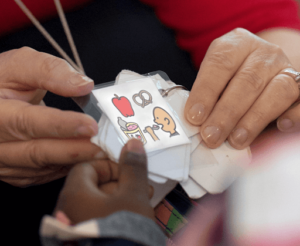
Encourage use of AAC in a variety of settings
In order for AAC skills to be generalized, these skills need to be practiced in a variety of settings. This means that AAC should be accessible, available, and functional in all daily routines.
For AAC users, their systems are their voice, so we should try not take these systems away. In situations where ‘talking’ or using the AAC system is discouraged (e.g., in a quiet movie theater, while teachers are speaking, during fire drills, etc.), we should simply work with the child to teach them that expectation, rather than physically removing his or her device.
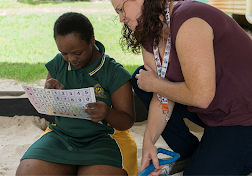
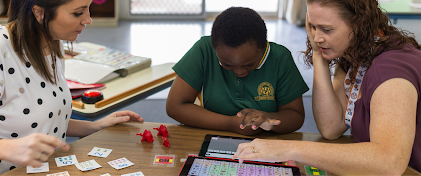
Provide meaning with what the child selects
In order to teach word meaning, always respond to what the child selects on the AAC system, even if it’s seemingly irrelevant or inappropriate at the moment. For example, if the child selects “apple”, you can say “we eat apples for breakfast!”. You can also go look for an apple in the kitchen, you can pretend to eat a fake apple, or you can ask “do you want a snack?”. If your child selects “all done”, then immediately stop what you’re doing, even if this is not what you *think* your child intended. One of the ways that children learn language is through this type of reinforcement
A great way to practice pairing meaning with your child’s selection is by providing choices to your child (e.g., “Would you like to run or walk?”). Model these words on the system and wait for your child to make the selection! Then, immediately reinforce by doing the action or providing the choice.
Honor all communication attempts
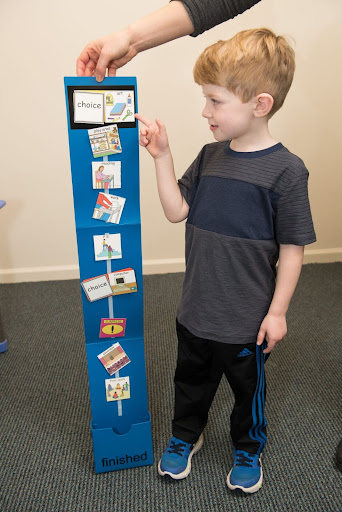 One of the primary goals of AAC usage is to help individuals develop functional communication skills, no matter the method of communication. Therefore, it’s important to honor every communication method made by your child. For example, if your child speaks instead of using his or her AAC device, honor that communication attempt by responding to what they say. If your child selects “all done” on the AAC system but does not sign “all done” or say “all done”, honor his or her request to be “all done”! It’s important to encourage your child to communicate and we can only do this by responding to their communication attempts- no matter the system.
One of the primary goals of AAC usage is to help individuals develop functional communication skills, no matter the method of communication. Therefore, it’s important to honor every communication method made by your child. For example, if your child speaks instead of using his or her AAC device, honor that communication attempt by responding to what they say. If your child selects “all done” on the AAC system but does not sign “all done” or say “all done”, honor his or her request to be “all done”! It’s important to encourage your child to communicate and we can only do this by responding to their communication attempts- no matter the system.
Be comfortable with making mistakes
Learning AAC can feel overwhelming, daunting, and generally unknown. If it feels this way to you, it likely feels this way to a new AAC user. Show your child that it’s okay to make mistakes, and even talk about your mistakes when using the system. This teaches your child that it’s okay to make mistakes, too! Trial and error is part of the process.
Note: This article is written from the perspective of a pediatric speech-language pathologist, and therefore, references ‘children’ throughout the entirety of the article. However, this information can be applied to all age-groups and populations.
Questions or concerns?
If you have questions or concerns about your child’s communication skills, please contact us at info@playworkschicago.com or (773) 332-9493. The Speech-Language Pathology team and the Assistive Technology team are available to provide individualized AAC recommendations based on your child’s needs.
Nicole Sherlock, MA, CCC-SLP
Speech-language Pathologist
Assistive Technology Co-Coordinator
Photo by PRC-Saltillo retrieved at:
https://store.prc-saltillo.com/image/catalog/ViaPro/Via-Pro-all-three-colors.jpg
Photo by AbleNet Inc., retrieved at: https://www.ablenetinc.com/quicktalker-ft-7/
Photo by Talk to Me Technologies, retrieved at: https://www.talktometechnologies.com/products/zuvo-12
Photo by Alexander Dummer on Unsplash
Photos by Tobii Dynavox, retrieved at: https://us.tobiidynavox.com/collections/low-tech-aac/products/picture-communication-symbols-pcs
Photos by Assitive Ware, retrieved at: https://www.assistiveware.com/learn-aac/planning-communication-when-aac-is-not-available
https://www.assistiveware.com/learn-aac/get-the-team-on-board
Photo by Pyramid Educational Consultants, retrieved at: https://pecsusa.com/shop/schedule-board-kit/#tab-description
